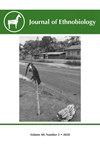了解Yucatán半岛上玛雅鱼类使用的元分析方法
IF 1.3
3区 社会学
Q1 ANTHROPOLOGY
引用次数: 0
摘要
摘要这项荟萃分析使用了来自玛雅北部低地的七个先前发表的鱼类群落,以评估环境或人类社会因素,如精英地位,是否推动了终端到后古典时期对沿海贸易的日益重视。在终端经典时期,随着玛雅低地中部和南部遗址的政治衰落,玛雅低地北部崛起。随着政治制度的变化,经济制度也发生了变化。利用物种面积曲线、丰富度、嵌套性、非度量多维尺度、均匀度和栖息地差异,本文探讨了玛雅北部低地的鱼类贸易在多大程度上是由栖息地差异、地点与海岸的距离、时间段或社会地位驱动的。研究结果表明,社会因素而不是环境因素更多地解释了每个地点鱼类分类组成的变化。不同的分类群落与其说是由特定的环境因素、恢复方法或鉴定程序来解释,不如说是由地点与海岸的距离和地点的社会背景来解释(即精英与非精英)。这些数据表明,荟萃分析可以解释基于访问的差异——例如与海岸的站点距离或特定集合的社会背景——是如何在复杂社会中的大型动物数据集中表达的。本文章由计算机程序翻译,如有差异,请以英文原文为准。
A Meta-Analysis Approach to Understanding Maya Fish Use on the Yucatán Peninsula
Abstract. This meta-analysis uses seven previously published fish assemblages from sites in the northern Maya lowlands to evaluate if environmental or human social factors, such as elite status, provided impetus for the increased emphasis on coastal trade during the Terminal to Postclassic periods. Following the political decline of sites in the central and southern Maya lowlands during the Terminal Classic period, the northern Maya lowlands rose in prominence. As political systems changed, so too did economic systems. Using species area curves, richness, nestedness, non-metric multidimensional scaling, evenness, and differences in habitat, this paper addresses to what degree fish trade in the northern Maya lowlands was driven by habitat differences, site distance from the coast, time period, or social status. The results indicate social factors, rather than environmental, explain more of the variation in the fish taxonomic composition at each site. The different taxonomic communities are explained less by specific environmental factors, recovery methods, or identification procedures than by site distance from the coast and social context of the site (i.e., elite versus non-elite). These data demonstrate that meta-analyses can explain how access-based differences—such as site distance from the coast or due to the social context of a particular assemblage—are expressed among large faunal datasets within complex societies.
求助全文
通过发布文献求助,成功后即可免费获取论文全文。
去求助
来源期刊

Journal of Ethnobiology
Social Sciences-Anthropology
CiteScore
4.80
自引率
3.40%
发文量
21
审稿时长
>12 weeks
期刊介绍:
JoE’s readership is as wide and diverse as ethnobiology itself, with readers spanning from both the natural and social sciences. Not surprisingly, a glance at the papers published in the Journal reveals the depth and breadth of topics, extending from studies in archaeology and the origins of agriculture, to folk classification systems, to food composition, plants, birds, mammals, fungi and everything in between.
Research areas published in JoE include but are not limited to neo- and paleo-ethnobiology, zooarchaeology, ethnobotany, ethnozoology, ethnopharmacology, ethnoecology, linguistic ethnobiology, human paleoecology, and many other related fields of study within anthropology and biology, such as taxonomy, conservation biology, ethnography, political ecology, and cognitive and cultural anthropology.
JoE does not limit itself to a single perspective, approach or discipline, but seeks to represent the full spectrum and wide diversity of the field of ethnobiology, including cognitive, symbolic, linguistic, ecological, and economic aspects of human interactions with our living world. Articles that significantly advance ethnobiological theory and/or methodology are particularly welcome, as well as studies bridging across disciplines and knowledge systems. JoE does not publish uncontextualized data such as species lists; appropriate submissions must elaborate on the ethnobiological context of findings.
 求助内容:
求助内容: 应助结果提醒方式:
应助结果提醒方式:


